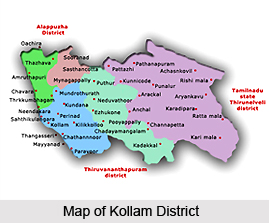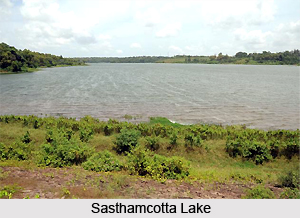 Kollam or Quilon is an old seaport town on the Arabian coast, which stands on the Ashtamudi Lake. From the past days of Phoenicians and the Romans, the kollam, which was formerly Desinganadu, had a sustained commercial reputation. In the 14th century Ibn Batuta traveled a long period of about twenty-four years. At that time he regarded this Kollam port as one of the five main ports of Kerala.
Kollam or Quilon is an old seaport town on the Arabian coast, which stands on the Ashtamudi Lake. From the past days of Phoenicians and the Romans, the kollam, which was formerly Desinganadu, had a sustained commercial reputation. In the 14th century Ibn Batuta traveled a long period of about twenty-four years. At that time he regarded this Kollam port as one of the five main ports of Kerala.
Kollam District can be called as an exact miniature of Kerala. It is gifted with unique representative features such as Sea, lakes, plains, mountains, rivers, streams, backwaters, forest, vast green fields and tropical crop. The crops are of both the variety food crop and cash crop. So this district is genuinely called as `The Gods Own Capital`.
District Information:
Kollam District is situated on the South west coast of kerala. The four boundaries of the district can be mentioned as on the north it is bound by Alappuzha and north east by Pathanamthitta Districts on the east by Thirunelveli District of Tamilnadu, while on the South it is bound by the Thiruvavanathapuram District and on the west by Arabian Sea.
Two rivers Kallada and Ithikkara flow through this District. The Sasthamcotta Lake is the only major fresh water lake in the Kerala state, which is placed in Kollam District.
The total district area is 2491 sq.km. The population of which is 25,84,118. The climate present is mainly tropical while the annual rainfall is approximately 270 cm. the mean maximum temperature is 36 degree C. while mean minimum temperature is 22.4 degree C. The main season for tourist`s visit mainly starts from august and lasts till March.
The Soil of the District may be classified as sandy loams, larerite and forest soil. The coastal belt has sandy loams and the forest soil is found in the eastern forest belt. The rest of the district is laterite soil.
The District has a tropical humid climate with an oppressive summer and plentiful seasonal rainfall. The summer season which last from March to May is followed by the South West Monsoon from June to September. The rest of the year is generally dry.
Kollam district, which is at a distance of 71 km away from Thiruvananthapuram, is a very important for the State`s trade and commerce. It is also the centre of the country`s cashew trading and processing industry.
This is an important hub for State`s marine product industry. This district has a large forest area. The forest divisions are at Thenmala and Punalur. The names of some of the blocks having large areas of forest are as follows: Pathapuram, Anchal, Kottarakkara, and Chadayamangalam.
Thus the district Kollam is very rich with its natural gifts of wide rivers, dominant hills and forest, lakes and plains that combines and resulted into the wonders of the modern age with the traces of a bygone era.
Agriculture:
The district has a prominent place in the field of agriculture. The total cultivated area is 2,18,267 hectares. The principal crops are paddy, tapioca, coconut, rubber, pepper, banana, mango and cashew. About 70 per cent of the work force is engaged in agriculture as this is regarded as the most productive occupation in this district. Coconut gardens extend to about 75,454 hectares in which the production raises up to three hundred and forty three million in numbers every year.
The five major crops are paddy, tapioca, coconut, rubber, pepper. These are cultivated in an area of 1,73,847 hectares. More than 95% of the total farming community is constituted by the Small and marginal farmers. The average per family holding is 0.21 hectare.
All the 71 Panchayat of the district are covered by separate Krishi Bhavans. There is an Oil Palm Plantation at Bharatheepuram near Anchal. This is planted in an area of 4000 hectares, under the Oil Palm India Ltd., which is a state government undertaking. Another State Government undertaking is the Rehabilitation plantations, which is located at Kulathupuzha near Thenmala.
Education:
The District offers well-developed educational facilities. The rate of literacy is 91.47%. The educational infrastructure includes 473 lower primary schools, 213 upper primary schools, 211 high schools, 14 arts and science colleges, 8 teachers training centers, 2 training colleges, 30 ITIs and Tics, 2 junior technical schools, three polytechnic and three engineering college. Besides, there are 2107 anganavadi centers too. All the colleges, A & S colleges except a junior college at Chavara are in the private sector. A fisheries school at Alappad and the Kendreeya Vidyalaya at Kottarakkara are the unique feature of the educational sector.
Transportation:
Kollam district is well connected by Roads, Railway, Waterways and also Sea Ports.
Railway:
Kollam is regarded as an important railway junction. The railway lines covered 132 km of the Kollam district. Out of the total railway lines 51 km are broad gauge and 81 km are metre gauge. There are 22 railway stations of which 9 are on broad gauge line and 13 are on the metre gauge line.
The Trivandrum-Ernakulam which goes via Kottayam and Alappuzha line pass through Kollam. Kollam is the terminal junction of Madras-Egmore-Kollam metre gauge line.
Road
Kollam has a total 1552.096 km of roads. The NH 47 covers a distance of 57.4 km in the district. The State Highway namely Main Central Road, Kollam-Shencottah Road and Punalur-Pala-Muvattupuzha which is Main Eastern Highway with a total length of 266.52 km also networks the district.
 Water Transport:
Water Transport:
The Water Transport Department operates boat services to Muthiraparamb in West Kallada, Guhanandapuram, Ayiramthengu, Munrothuruthu and Alappuzha. The Alappuzha service opens a vast landscape of tourist attraction. A full day on board journey through the backwaters provides an opportunity to witness the natural life of the people around and the scenic beauty of the place.
Luxury boats, both of the Government and private parties, operate from the main boat jetty during the season. The west coast canal system, which starts from Thiruvananthapuram in the south and ends at Hosdurg in the north, passes through Kollam and Karunagappally taluks.
Ports:
Neendakara and Kollam are the two ports in the district. Neendakara is an intermediary and the latter is a minor port. Port operations are carried out through Neendakara.
District administration:
The Quilon or Kollam district is divided both on geographical and functional basis for the better purposes of general administration. Geographically it is divided into Revenue Divisions, five Taluks and 104 Villages whereas functionally the District administration is carried on through the various Departments of the State Government. Each of these has an office of its own in the district level.
Demographics:
The total population of the district is 25.84 Lakhs. The district ranks sixth in case of population in the state. The density of population of the district has increased from 961 persons per Sq. km in 1991 to 1037 in 2001, which is a great raise.
Sex Ratio, which can be defined as the number of females per 1000 males, shows a fluctuating trend from decades to decades.
In all other decades there was a dominance of males over females. According to the 2001 census there are 1070 females for every 1000 males, while it was 1035 in 1991 census.
Taluks and villages:
The whole Kollam Revenue District is divided into five Taluks and 104 Villages. The tahsildar in charge of each taluk is primarily the Revenue Official responsible for the collection of revenue. He is also expected to be in direct contact with the people at all levels and to have first hand knowledge of the conditions of every village under his jurisdiction. Village Officers and Village Assistants assist the Tahsildar in each village, which is a regular process.
Mineral Resources:
The district is immensely rich in mineral resources. The sands that are usually found on beaches of the district have concentrations of heavy minerals like Limonite, Rutile, Monosite and Zircon, which offer scope of exploitation for industrial purpose.
Besides large deposits of China clay in Kundara, Mulavana and Chathannoor, there are also lime shell deposits in Ashtamudi Lake, Bauxite deposits in Adichanallur while disseminated graphite deposits in Punalur.
Irrigation:
The district is gifted with persistent supply or flow of water with the two rivers. During 1953, in order to increase the irrigation potential, several plans were evolved to undertake river basin schemes. Kallada Irrigation Project is the biggest multipurpose project undertaken by the State Government. It has proposed to utilize the water of Kallada River, mainly for irrigation purpose in Kollam, Pathanamthitta and Alappuzha districts. There is also a proposal to generate 50 M.W. of electricity from the dam at Thenmala.
The Kallada project comprises of a Masonary dam of 335 m. in length with a maximum height of 81 m. at Parappur in Thenmala. This project has been constructed across the river to form a reservoir, a pick up block and sluices at Ottakkal. The 69 km right bank canal and the 57.75 km left bank canal take off from the pickup barrier. It is estimated that the two canals together will serve an area of 68,000 hectares. The World Bank has helped to improve these projects.
Improvement of Perumkulam yelah in Kollam taluk, West Kallada Scheme in Kunnathur Taluk, reclamation of Polachiral Lake in Kollam Taluk and Ithikkara yelah schemes, are some of the medium irrigation schemes in the district.
The State Government has taken up major and medium irrigation schemes directly. The individual minor irrigation schemes, viz., dug-wells, bore-wells, tube- wells, pump sets, commercial co-operative banks are financing drip and sprinkler irrigation systems.
Animal Husbandry:
Kollam district ranks first in livestock wealth in the Kerala State. Dairy farming has also developed quite well. According to 1987-88 livestock census there are 3.12 lakh milch cattle. A network of one district veterinary centre, 2 polyclinics, 48 veterinary dispensaries, 14 veterinary hospitals, and 167 artificial insemination centres, gratify the needs of the district. The number of cows increases annually by five per cent. There are about 65 milk producers` co-op. societies and three chilling plants.
Fisheries:
Kollam is an important marine district of the state with a vast coastline of 37.3 kms. Fishing has taken a prominent place in the economy of the district. Neendakara and Sakthikulangara villages always flourish in fishing. An estimated number of 23,000 persons are engaged in fishing and related activities. Some of the important fishing villages can be named as Cheriazheekkal, Alappad, Pandarathuruthu, Puthenthura, Neendakara, Thangasseri, Eravipuram and Paravoor. These are the eight important one out of 26 fishing villages. There are also 24 inland fishing villages. Considering the unique location and infrastructure available here, the Government has initiated steps for establishing a fishing harbour at Neendakara, which is expected to enhance fish production by 15%. Average fish landing is estimated to be 85,275 tonnes per year. One third of the state`s fish catch is form Kollam.






